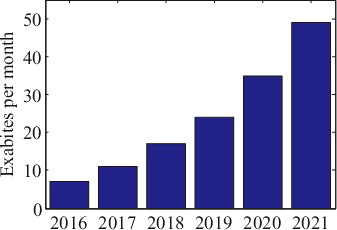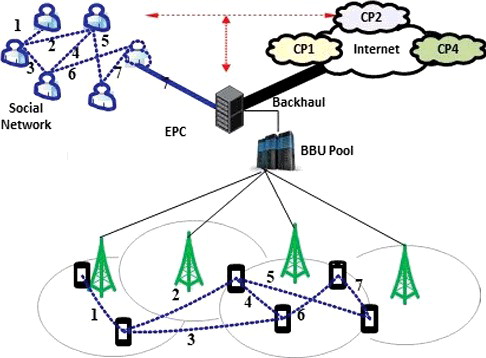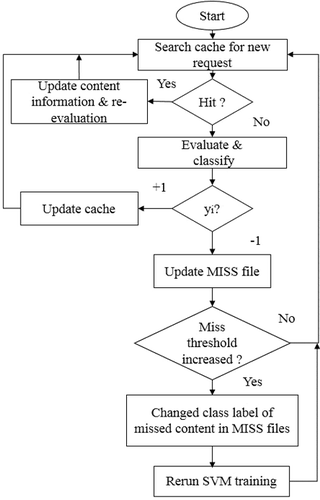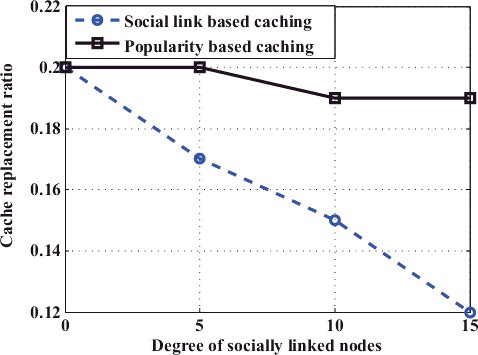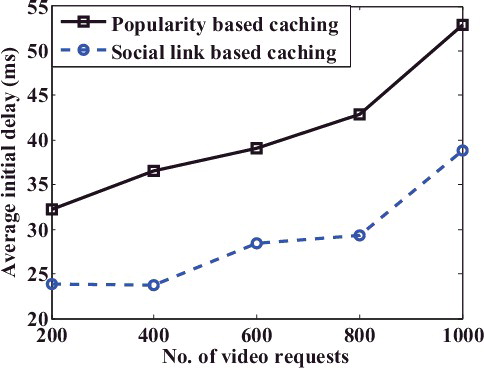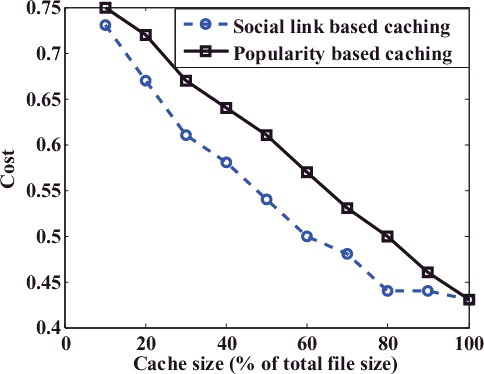ABSTRACT
Next-generation 5G networks are envisioned to support ultra low latency, leveraging the benefits of caching at radio access network (RAN). While the low latency is proliferated by proactive caching, cache efficiency depends on caching the right data. Social behaviour of mobile users and highly evolved learning algorithms are the new trends to support the network evolution for improved quality of experience to the users. In this paper, we explore a proactive caching scheme that takes the advent of social ties of mobile users accessing the cached contents. By exploring users behaviour and cached content properties, the proposed system not only increases cache efficiency but also improves 5G network capabilities. Simulation with real-world observations shows 14% − −28% improvements in the cache hit ratio with reduced cache replacement rate. Application of the proposed caching policy with hierarchical video caching in 5G network improves delay by 10%.
1. INTRODUCTION
The recent advancements in the mobile communication network and proliferation of smartphones have substantially fuelled the per-user data usage. Mobile data services are dominated by multimedia contents. Global wireless mobile statistics shows that mobile video will account for 75% of total mobile data traffic [Citation1]. Cisco predicts the mobile video traffic growth will increase by seven times in 2021 [Citation1]. shows this expected projection trends in mobile video traffic. With 15% traffic share, social networking is the second largest contributor of mobile data traffic [Citation2]. However, current centralized wireless network is not efficient enough to cope with the explosive growth in mobile traffic and quality-of-service requirement [Citation3].
This next-generation 5G Radio Access Network (RAN) system will be the cooperative integration of evolving and already existing multiple RATs [Citation4]. In order to satisfy high traffic demands, the 5G wireless needs deployment of ultra-dense small cells [Citation5]. Moreover, it will include the Cloud-RAN (C-RAN) architecture which combines the advantage of low capital and operational expenditure, scalability, and high data rate. Cloud-based cooperative radio access management and cloud-computing-based self-organizing network can significantly improve spectral and energy efficiency of 5G RAN [Citation6]. While the back-haul traffic can be supported by high-speed optical fibre network, the front-haul needs to adapt new RAN technology and protocols. 5G RAN systems will adapt to mmWave or extremely high-frequency band in order to satisfy ultra-dense network broadband applications.
From the network point of view, though small-cell deployments is a solution to achieve faster data rate, it involves high deployment cost and strains current cellular infrastructures [Citation7]. Further, the reactive nature of current cellular network is questionable on its ability to achieve ultra-low latency. Hence the new 5G paradigm needs to focus on storage developments, context awareness, and social networking [Citation7,8].
Redundant access to popular multimedia contents is one major reason for the traffic explosion problem [Citation9–12]. From the communication point of view, though redundant content access is the reason of traffic explosion, it also leverages solution for low latency. Efficient caching strategy for the popular contents at mobile network not only alleviates the traffic explosion problem but also reduces the content access delay and energy consumption in 5G wireless networks. Social network and network intelligence are going to take a major role in future network design. Machine learning techniques and data mining with big data are proven to be effective in analysis and prediction of outage detection, useful content suggestion, proactive scheduling, and peak traffic prediction [Citation7,13]. At the same time, online social networks play significant role in content sharing. The users tend to access contents, shared and recommended by friends with similar interests. In terms of the social distance, 90% viewers of a video content are within two-hop friends of video owner, including 70% one-hop friends [Citation14]. User-generated content sharing has evolved to a major trend in online social networks [Citation14]. Due to the social links, most of the traffic produced at edge network are consumed at edge network itself.
Proactive caching [Citation7] and efficient caching [Citation9] in the wireless network are gaining more attention across 5G research communities. “What to cache?” has been an important research direction for the wireless network. Popularity ranking is widely used as the basis of proactive caching. However, the popularity of any content is based on the number of global access of a content, which might vary depending on geographical locations, user influence, and content properties. Second, during peak traffic period, frequent cache replacements might replace contents that have high possibilities of access in future. So, only popularity-distribution-based caching may not be suitable for every caching system. Unfortunately, besides popularity ranking, not many attributes and their influence have been taken into account for caching decision. In this paper, we propose an efficient caching framework that takes cache decision based on video content properties as well as user's social status. Using Support Vector Machine (SVM), a supervised learning algorithm, we classify the video contents dynamically. Our contributions in this papers are as follows:
| (1) | We propose a new caching algorithm based on social connections of users and multiple video attributes. | ||||
| (2) | We show that optimal caching in 5G-RAN is an NP complete problem. Subsequently, we use SVM to classify the potential data to be cached. | ||||
| (3) | We construct our simulation data based on actual data usage. Simulation results shows 10% improvement in cache hit ratio with 25%–50% reduced cache replacement operation. | ||||
| (4) | Application of the proposed caching policy with 5G RAN caching architecture improves video content access delay by 10% as compared to popularity-based caching [Citation15]. | ||||
The rest of the paper is organized as follows. Section 2 highlights the recent caching works in wireless networks. System model and problem background are presented in Section 3. Section 4 delineates our proposed algorithm. Simulation and results in Section 5 substantiate the usefulness of our algorithm. Finally, we conclude this work in Section 6.
2. RELATED WORK
Detail caching paradigm of Evolved Packet Core (EPC) and RAN caching is shown in [Citation9,16]. Related literature in RAN caching, based on social networks and influence on content distribution, is available in [Citation7,14,17]. The works in these literature emphasize on contents pre-fetching. Caching based on cost function is discussed in [Citation16,18–20].
Three major caching-related issues are (i) Where to cache?, (ii) What to cache?. Wang et al. [Citation9] discuss the essence and role of caching in 5G networks. With detailed analysis of caching paradigms, in context to the above questions, a novel RAN caching scheme based on content-centric networking is proposed. Content caching in EPC and RAN has been discussed in [Citation9,15]. Using Zipf distribution-based hierarchical caching, Umrao et al. [Citation15] show that caching at the RAN significantly reduces video content access delay. Greedy replacement and collaborative caching mechanism [Citation16] with EPC and several eNodeB are helpful in reducing the bandwidth cost. Greedy of-line caching [Citation18] algorithm is better than online algorithm in terms of the number of calculation and replacement operations. Describing caching as a solution to low-latency and cost-efficient networks, Bastug et al. [Citation7] proposed a proactive caching mechanism for small-cell network. Using popularity-based content ranking and user influence, the authors design a popularity matrix to retrieve contents with high access probability. In [Citation17], Cheng and Liu build a social relationship between videos, and proposed a pre-fetching strategy based on social network. Proactive caching in [Citation21] preaches video contents to base stations in order to reduce the content retrieval delay. Thus, a mobile user moving to a new cell can access video contents immediately.
Big data framework for proactive caching for telecommunication is discussed in [Citation22]. Analysis performed on real data trace shows that proactive caching achieves 100% of request satisfaction and 98% of back-haul offloading. Tabassum et al. [Citation23] proposed a predictive prefetching of data, obtained by processing the past references, to derive the probability of future access based on data mining technique that is expected to improve the performance of data retrieval in location-dependent environment thus providing efficient mobility management. Analytical model resented in [Citation24] suggests that geographical impact on caching cannot be ignored. Further, cache performance can significantly benefit from the presence of even a relatively small portion of highly cacheable (popular and local) contents [Citation24].
The role of the social network in content distribution and characteristic of video consumption by social network user is analysed in [Citation14]. The authors also propose a prefetching and buffer management algorithm based on social networks. Using geographic influence index, content propagation index, and social influence, Wang et al.[Citation20] propose a replication strategy to improve the video service quality. A decentralized caching strategy for coordinating content retrieval in cooperative small-cell networks has been proposed in [Citation19]. This paper formulates a cost model for data retrieval from EPC and small base stations. Based on the cost model, a heuristic algorithm has been proposed. Different from the human social network, Zhang et al.[Citation25] propose social relation between the base station to decide the important base station to cache data. Social network link and client mobile device mapped in [Citation26] to pro-actively cache content in client's device. Although, this work improves hit ratio, it might create additional radio resource and data charges.
Our work in this paper is motivated from the works in [Citation7,9]. Both of these caching schemes consider popularity content being accessed using Zipf distribution [Citation27]. However, content popularity based on a global statics does not hold true for local content access. In this paper, we consider multiple attributes of video contents, user social network parameters, and design a caching strategy based on machine learning algorithm.
3. SYSTEM MODEL
We consider the downlink traffic of a 5G cellular network as depicted in . In our system, N small base stations (SBSs) are deployed. Each SBS has a corresponding storage units in baseband unit (BBU). SBSs are connected to the EPC with higher storage unit. H users in the network access I files randomly. A graph (V,E) represents the social ties among the users in the cells. For simplicity, we only focus on video access instead of general file. The cache in EPC or eNB stores a chunks of video files with equal size S. We assume the link delay d between EPC to SBS and SBS to user is to be the same.
We assume that the social network information of users is available to content provider. The mapping of social relation and actual mobile user is shown in using numeric codes. Although there might be privacy issue with the user, we believe that future network will benefit from the cooperation of content providers, social network operators, and mobile network operators. Each video file as well as video user has some open shared properties ai. Each of these properties have some contribution for the video to be “most likely to be watched”. Initially, such videos are cached in the EPC by default. Videos with higher number of possible viewer under any SBS would be cached in the SBS.
In the literature, popularity-based caching is used by many authors [Citation7,14]. Zipf distribution [Citation27] is widely used to model content popularity. Zipf distribution ranks F contents based on popularity (1 represents the most popular). When there are total R number of requests in a time duration t, the popularity of any content v, Rv, using Zipf distribution is given as
(1)
The popularity Rv of a content varies globally, and might not be applicable for a given locality. Hence, the popularity-based caching may not always be suitable for RAN caching. Caching decision based on individual content properties is highly biased. For example, a highly popular video vp in a geographical region, A, may not be accessed by many users in a different region B. Let a visitor from A1 access the file while roaming in region B. Since vp has high popularity value, it might be cached by SBS in B with little or no future usage. Thus, it may negatively influence the caching decision in the network of region R2.
Caching decision of a video depends on both the video as well as user influence in the network [Citation7]. Thus multiple video properties might need to be considered while taking caching decision. Let the set of attributes A = {a1, a2, ..., an} represent properties of video being accessed, such that at least one ai ≠ 0. The objective is to classify the video caching decision to a class with two values: “yes and no”. Each ai has positive influence towards the objective function. Let the influence of ai be wi. The objective function is
(2)
Since Equation (Equation2(2) ) is always positive, we define a positive boundary β. Now the “yes and no” can be mathematically represented as ≥β and ≤β, respectively.
If the number of requests for file v associated to BSi in region Ri follows the Poisson probability distribution with rate parameter λ
i
v, it becomes(3)
where λ
i
v ⩾ 0 (requests per time unit) denotes the average demand for file v generated by the users associating to BS i.
Subsequently, new videos originating from the current network may initially have low popularity value. But they might have high possibilities of being requested by many socially connected user. Hence it is necessary to balance the influence of each attributes, i.e. wi should be set properly.
Let yi
v
be a binary decision variable which indicate whether video v is cached at eNodeB i. If video v in cache of node i, yi
v
= 1; otherwise yi
v
= 0. If a local eNodeB i fulfils a request for video v, the cost reduction is r0 + ri. If other eNodeB j(j ≠ i) fulfils this request for video v, the cost reduction is written as r0 + ri − rij. If the EPC cache fulfils the video request, then the unit cost reduction is r0. Otherwise, the request for v will be redirected to the server with zero saving. Then the total cost saving with a request rate γ
i and video size S can be calculated as
(4)
(5)
The objective is to increase the cost saving by caching appropriate video with high value, where the value of video is the number of times it is accessed. For a given cache size, the objective is to decide yi
v
. The problem of finding the optimal cost saving in Equation (Equation4(4) ) is NP-complete. The proof is given in the following paragraph.
The 0–1 knapsack problem can be mapped to our problem. We can consider the knapsack as an eNodeB, the knapsack capacity as SBS/EPC cache size, items to be chosen for the knapsack as content to be cached. Let us consider the cost saving of items to be the benefit of cached objects and the weight of items as the sizes of contents, then the knapsack problem is naturally transformed to the problem of maximizing local caching benefits at a EPC.
While it is difficult to optimally solve the 0–1 knapsack problem, approximation solutions can be achieved within a polynomial computation time. Let us consider the SBS/EPC as the knapsack and the content object as the item. The objective is to consider the most “probable” contents to be cached in the SBS/EPC. The probability of caching a content increases with a higher value of ai. We use SVM learning for the same as discussed in the subsequent sections.
3.1 Support Vector Machine
SVM is a machine learning technique that classifies both linear and nonlinear data. SVM uses a nonlinear mapping to transform the original data to a higher dimension. With the new dimension, SVM searches for the linear optimal separating hyper-plane to separate the data from the two classes. It finds the hyper-plane using support vectors (essential training tuples) and margins [Citation28]. SVM is preferred over other classifiers because of its nonlinearity and computational efficiency. It is a robust classifier, i.e. it can capture the more complex relationship between data points without difficult transformation. Moreover, SVM showed higher accuracy in classification and known to be more efficient for two-class classification [Citation28].
Let data D be {(a1, y1), …(av, yv), (a|D|, y|D|}, where av is the set of training tuples, which includes the user and video attributes, associated with the class labels yv, having two values: 1 for cache and 0 for no cache. SVM searches for the hyper-plane with maximum marginal hyper-plane. A separating hyper-plane is written as w.a + b = 0, where w = w1, w2, …, wn is a weight vector for different video and user attributes, b a scalar (bias), and a is a sample tuple (vector). The hyper-plane defining the sides of the margin is represented as
(6)
(7)
Any training tuples that lie on hyper-planes H1 or H2 (both sides of margin) are formal support vectors.
4. PROPOSED CACHING ALGORITHM
On arrival of new video requests, our proposed algorithm collects properties of the video files and retrieves the requesting users’ information. For a cache hit, the algorithm updates cached content information (described later in this section). On the other hand, for a cache miss, based on the recent yi values, the algorithm decides whether to cache or not. Information of contents that is not being cached is added to a file (MISS file) for future training. When the cache miss increases beyond a certain threshold, the missed contents class labelled are changed, and the algorithm starts another training. The proposed algorithm is described in and the corresponding flow chart is given in . The training process obtains new rules and replaces cache contents if necessary. In the following subsection, we discuss training and cache replacement.
Algorithm 1: Proposed caching algorithm
4.1 Training and Cache Replacement
Flow chart and algorithm of training and cache replacement are given in and . The training and replacement algorithm takes training data from both MISS file and cached data. If any video file has been missed more than a predefined threshold, then the class labels of that video content are set to “yes”, i.e. yk = 1. After obtaining new training rules, new class labels are applied to each cached video and video information in MISS file. In the case of a replacement, video files with lower H1 or H2 values are replaced first.
Algorithm 2: SVM Training and replacement
4.2 Cache Content Update
With any successful cache hit, dynamic cache content attributes need to be updated for better predictions. Socially linked users: social link of the user requesting a content is an important parameter. When there is a cache hit by a new user, the new social link of the user increases the possibilities of future access. With each content access, the possibility of future access count decreases by a unit value. Attributes such as likes, views, and comments whose values increase constantly are updated by their rates of increase. Attributes such as language, origin, categories are used as categorical and constant values.
4.3 Cache Content Placement
The caching decision should be taken at the EPC to consider user across large geographical area. Potential content can be pushed to the SBS storage (in BBU) based on the possible user location in the SBS. A cached content should be kept in the SBS cache, if more numbers of one-hop friend are concentrated in ant SBS. With cache space available, the presence of more than one user may lead to SBS cache. However, when the cache space is full, priorities can be given to content with more potential users. If the users are distributed among multiple SBSs, the content should be kept in the EPC cache.
5. SIMULATION AND RESULTS
Our simulation set-up consists of three SBSs with 200 m radius in a densely populated area. Users in the cells are socially linked to each other (e.g. University campus). Each user is connected to its nearest SBS. The three SBSs are connected to the BBU with the backbone network. The access network follows 5G channel model [Citation29]. The link delay d between BBU to SBS and SBS to user are 1 ms each. The major parameters used in our simulations are summarized in .
Table 1: Simulation parameters
We observed different YouTube videos and personally shared videos in Facebook by 15 users over 10 days. We captured the number of shares and views by one-hop friends working in the same university. Different properties of videos considered in our SVM training are
the number of views in the past 24 hours,
likes, shares, and comments (LSC) by users.
video uploaded (edge or core),
language.
Properties of user requesting for video are
the number of one-hop friends within the same region,
influence factor (past number of view/share/comments),
subscriptions,
language preference.
Based on 200 real-world video data, we generate random data for 2000 users and 2000 video files. Initially, videos with more than three hits within 12 hours were labelled as cached video for training data. The SVM training shows that LSC by one-hop friends, the number of one-hop friends, and subscription strongly influence the video sharing. Other factors have less influence in the same locality. Thus we consider only three parameters for the SVM training in order to reduce the training load. We compared our proposed algorithm with popularity-based caching used over hierarchical caching [Citation15].
Most videos shared by a user are most likely to be viewed by friends and followers. One of the major drawbacks of the existing caching schemes is the lack of future predictions. Even if videos are likely to be watched by socially linked users, high traffic scenario may replace the cached contents before they are accessed by the socially linked users. demonstrates the hit ratio of our proposed scheme with popularity-based caching. By giving more priority to “most likely to be watched” videos, the proposed system outperforms popularity-based caching by 14%–28%.
The performance of social-aware caching scheme depends on social ties between users served under a single-cached device. As a result, cache replacements are low, when there are many possible users for any file. delineates the number of cache replacements with the degree of the socially linked node. When there are many followers, cache replacements are substantially lower. As represented in , our proposed scheme reduces the average cache replacement ratio by 14%, 21%, 40% when the average social link per users are 5, 10, 15, respectively.
shows the average video access delay with the increasing number of video requests. Proposed algorithm can reduce the average access delay by 30%–40%. presents the effect of the social-link-based caching on video file access. Apparently, considering the video access cost (in terms of bandwidth) from the server to user as 1, the social-link-based caching always incurs 2%–7% less cost than the popularity-based caching schemes. In , we have shown the initial delay for continuous video access over time. Socially link-based caching on hierarchical caching architecture [Citation15] shows up to 10% better performance than the popularity-based caching. Note that the major delay is from the core network to access the content.
summarizes the memory and CPU overhead requirement of social-link-based caching scheme. The additional memory requirements for 2000 video information (excluding the video size) is up to ∼100Kb and processing requirement is ∼16 × 107 CPU operations/sec. With the evolution of high-capacity processor and memory devices, this overhead is imperceptible.
Table 2: Overhead
6. CONCLUSION
In this paper, we proposed a caching scheme using SVM and user's social links. We performed system-level simulation of the proposed algorithm and compared with popularity-based caching schemes. Using social connection of the users, our algorithm not only improves cache hit ratio by 14%–28%, but also reduces the cache operation by 10%–50%.
In the current practice, the network operator has limited knowledge about user contexts. To achieve low latency for the 5G network, the backbone network processing should be improved along with the access network. As social networks are the largest cellular traffic source, quality of experience of the users can be enhanced by the information exchange between content provider, social network operator, and the network operator. However, it is difficult to merge diverse influence factor from multiple social networks because many influence factors are overlapping, dynamic, and redundant nature. Moreover, privacy and security are major concerns while sharing user's private information with different stake holders. Our research will encourage to look for new security and privacy policies for data sharing among stack holders, and common content evaluation procedure to enable the future 5G network to take advantage of social network information for better quality of service.
ACKNOWLEDGMENTS
This research was supported by Basic Science Research Program through the National Research Foundation of Korea (NRF) funded by the Ministry of Education [NRF-2016R1D1A1B03935633].
Additional information
Notes on contributors

Shatarupa Dash
Shatarupa Dash is currently doing her PhD degree in Department of Electrical and Computer Engineering, College of Information and Communication Engineering, Sungkyunkwan University, South Korea. Her research interests are named data networking, cloud computing, and 5G wireless communication.
E-mail: [email protected]

Bharat J. R. Sahu
Bharat Jyoti Ranjan Sahu is currently doing his PhD degree in Department of Electrical and Computer Engineering, College of Information and Communication Engineering, Sungkyunkwan University, South Korea. His research interests are LTE scheduling and traffic optimization, machine-to-machine (M2M) communications, and quality of experience in 5G.
E-mail: [email protected]

Navrati Saxena
Navrati Saxena is an associate professor and director of Mobile Ubiquitous System Information Center (MUSIC) in Software Department, Sungkyunkwan University (SKKU), South Korea. She was an assistant professor in Amity University India and a visiting researcher in University of Texas at Arlington, USA. She completed her PhD degree from the Department of Information and Telecommunication, University of Trento, Italy. Her research interests involve 4G/5G wireless, IoT, and smart grids. She serves in guest editorial and technical programme committee of international journals and conferences. She has co-authored one book (Taylor & Francis) and published in more than 50 international journals.
REFERENCES
- Cisco , Cisco visual networking index: Global mobile data traffic forecast update, 2016–2021, Indianapolis, IN: Cisco Press, Feb. 2017.
- Ericsson , “5G Radio access – Research and vision”, Stockholm, Sweden: Ericsson Technical Publications, 2012.
- X. Wang et al. , “A survey of green mobile networks: Opportunities and challenges,” ACM/Springer Mobile Netw. Appl (MONET), Vol. 17, no. 1, pp. 4–20, Feb. 2012.
- T. O. Olwal , K. Djouani , and A. M. Kurien , “A survey of resource management toward 5G radio access networks,” IEEE Commun. Surv. Tut., Vol. 18, no. 3, pp. 1656–86, Jul. 2016.
- M. Agiwal , A. Roy , and N. Saxena , “Next generation 5G wireless networks: A comprehensive survey,” IEEE Commun. Surv. Tut., Vol. 18, no. 3, pp. 1617–55, 2016.
- N. Saxena , A. Roy , and H. S Kim , “Traffic-aware cloud RAN: A key for green 5G networks,” IEEE J Selected Areas Commun., Vol. 34, no. 4, pp. 1010–21, 2016.
- E. Bastug , M. Bennis , and M. Debbah “Living on the edge: The role of proactive caching in 5G wireless networks,” IEEE Commun. Mag., Vol. 52, no. 8, pp. 82–89, Aug. 2014
- Intel , “Rethinking the small cell business model,” white paper, 2012.
- X. Wang , M. Chen , T. Taleb , A. Ksentini , and V. Leung , “Cache in the air: Exploiting content caching and delivery techniques for 5G systems,” IEEE Comm. Mag., Vol. 52, no. 2, pp. 131–39, Feb. 2014.
- J. Erman et al. , “To cache or not to cache – the 3G case,” IEEE Internet Comput., Vol. 15, no. 2, pp. 27–34, Mar. 2011.
- S. Woo et al., “Comparison of caching strategies in modern cellular backhaul networks,” ACM MobiSys., Jun. 2013.
- B. A. Ramanan et al. , “Cacheability analysis of HTTP traffic in an Operational LTE Network,” Wireless Telecommun. Symp., Phoenix, AZ, pp. 1–8, Apr. 2013.
- V. Etter , M. Kafsi , and E. Kazemi , “Been there, done that: What your mobility traces reveal about your behavior,” Int’l. Conference on Pervasive Computing, 2012.
- H. Shen , Z. Li , Y. Lin , and J. Li , “SocialTube: P2P-assisted video sharing in online social networks,” IEEE Trans. Parallel Distrib. Syst., Vol. 25, no. 9, pp. 2428–40, Sept. 2014.
- S. Umrao , A. Roy , and N. Saxena , “Multilevel hierarchical caching for efficient wireless video distribution,” IETE J Res., Vol. 63, no. 2, pp. 260–67, Nov. 2016.
- S. Ren , T. Lin , W. An , G. Zhang , D. Wu , L. Bhuyan , and Z. Xu , “Design and analysis of collaborative EPC and RAN caching for LTE mobile networks,” Comput. Netw, Vol. 93, Part 1, pp. 80–95, Dec. 2015.
- X. Cheng and J. Liu , “NetTube: Exploring social networks for peer-to-peer short video sharing,” IEEE INFOCOM, Rio de Janeiro, pp. 1152–60, Apr. 2009.
- Z. Ming , M. Xu , and D. Wang , “InCan: In-network cache assisted eNodeB caching mechanism in 4G LTE networks,” Comput. Netw., Vol. 75, Part A, pp. 367–80, Dec. 2014.
- F. Pantisano , M. Bennis , W. Saad ,, and M. Debbah , “In-network caching and content placement in cooperative small cell networks,” in International Conference on 5G for Ubiquitous Connectivity, Levi, Finland, pp. 128–33, Nov. 2014.
- Z. Wang , L. Sun , et al. , “Propagation-based social-aware replication for social video contents,” in ACM International Conference on Multimedia, New York, pp. 29–38, 2012.
- J. Qiao , Y. He , and X. S. Shen , “Proactive caching for mobile video streaming in millimeter wave 5G networks,” IEEE Trans. Wireless Commun., Vol. 15, no. 10, pp. 7187–98, Oct. 2016.
- Ejder Bastug , et al. , “Big data meets telcos: A proactive caching perspective,” J. Commun. Netw., Vol. 17, no. 6, pp. 549–57, Dec. 2015.
- K. Tabassum , M. Hijab , and A. Damodaram , “A data mining approach for cache replacement in location-dependent environment,” in 2010 Second International Conference on Computer Research and Development, Kuala Lumpur, 2010, pp. 126–30.
- S. Traverso et al. , “Unravelling the impact of temporal and geographical locality in content caching systems,” IEEE Trans. on Multimedia, Vol. 17, no. 10, pp. 1839–54, Oct. 2015.
- J. Zhang , X. Zhang , Z. Yan , Y. Li , W. Wang , and Y. Zhang , “Social-aware cache information processing for 5G ultra-dense networks,” in Int’l Conference on Wireless Communications & Signal Processing, Yangzhou, 2016, pp. 1–5.
- S. Nikolaou , R. Van Renesse , and N. Schiper , “Proactive cache placement on cooperative client caches for online social networks,” IEEE Trans. Parallel Distrib. Syst., Vol. 27, no. 4, pp. 1174–86, Apr. 2016.
- D. M. W. Powers , “Applications and explanations of Zipf's law,” in Association for Computational Linguistics, 1998, pp. 151–60,
- J. Han and M. Kamber , Data Mining: Concepts and Techniques. San Francisco, CA: Morgan Kaufmann Publishers, Mar. 2006.
- T. S. Rappaport et al. ,“ Broadband millimeter wave propagation measurements and models using adaptive beam antennas for outdoor urban cellular communications,” IEEE Trans. Antennas Propag., Vol. 61, no. 4, pp. 1850–59, 2013.

